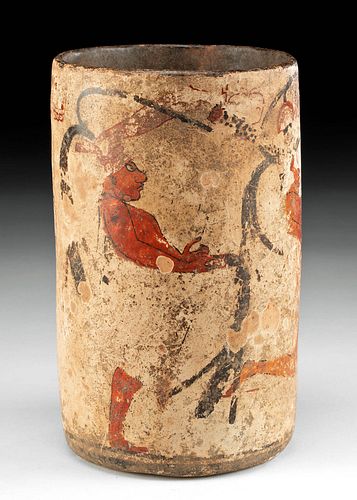Important Maya IK' Group Polychrome Cylinder w/ Cacique
About Seller
686 S Taylor Ave, Ste 106
Louisville, CO 80027
United States
Selling antiquities, ancient and ethnographic art online since 1993, Artemis Gallery specializes in Classical Antiquities (Egyptian, Greek, Roman, Near Eastern), Asian, Pre-Columbian, African / Tribal / Oceanographic art. Our extensive inventory includes pottery, stone, metal, wood, glass and textil...Read more
Two ways to bid:
- Leave a max absentee bid and the platform will bid on your behalf up to your maximum bid during the live auction.
- Bid live during the auction and your bids will be submitted real-time to the auctioneer.
Bid Increments
| Price | Bid Increment |
|---|---|
| $0 | $25 |
| $300 | $50 |
| $1,000 | $100 |
| $2,000 | $250 |
| $5,000 | $500 |
| $10,000 | $1,000 |
| $20,000 | $2,500 |
| $50,000 | $5,000 |
| $100,000 | $10,000 |
| $200,000 | $20,000 |
About Auction
Nov 10, 2022
Museum-worthy examples of classical antiquities (Egyptian, Greek, Roman, Near Eastern), Viking, Far East / Asian, Pre-Columbian, African / Tribal, Oceanic, Native American, Spanish Colonial, Nautical, Fossils, Ancient Jewelry, Fine / Visual Arts, so much more! Artemis Gallery info@artemisgallery.com
- Lot Description
Pre-Columbian, Guatemala, Central Peten Lowlands, IK' Polity (Motul de San Jose), IK' site group 1 or 2, Maya, Late Classic Period, ca. 750 to 850 CE. A cylindrical buff earthenware vessel of the IK' site group bearing red, orange, black, brown, and pink polychrome on creamy white slip; the interior rim boasts a black scalloped motif. Illustrated are 2 right-facing figures, one kneeling and one standing behind, both with orange-red skin and wearing headdress with sweeping black feathers. An additional pair of left-facing figures are shown opposite the first pair, with one seated upon a throne with arms crossed in his lap, and one standing - perhaps the nicknamed "Fat Cacique" - with a voluminous waist holding one hand out in front of his chest. Several pink-hued glyphs are written in a non-PSS (primary standard sequence) and perhaps provide a dedication to the depicted event, the proceedings of said event, and a list of the attendees' names including that of the host. Size: 4.45" Diameter x 7.2" H (11.3 cm x 18.3 cm)
According to Maya expert Doris Reents-Budet, "The IK'-style is characterized by its historical subject matter, recording sociopolitical and ritual events enacted by such rulers as the 'Fat Cacique' and Lord Completion-Star and their subordinate dignitaries from throughout the polity. Other characteristics of the IK'-style vessels include a bright white background, black-painted rims with a scallop motif embellishing the inside of the rims, and glyphs outlined in a dark rose color and sometimes filled with a lighter and more translucent pink wash. Interestingly, the IK'-style seems to be represented only by vases and flat-bottomed dishes with outflaring walls. Notably absent are plate forms, strongly suggesting a specialized function for these vessels." (Dorie Reents-Budet. "Painting the Maya Universe: Royal Ceramics of the Classic Period." Duke University Press, 1994, p. 172)
Cf. Dorie Reents-Budet. "Painting the Maya Universe: Royal Ceramics of the Classic Period." Duke University Press, 1994, Ch. 5, pp. 166-170, figs. 5.2, 5.4, and 5.5
Provenance: ex-Marc Amiguet Schmitt estate, Amiguet's Ancient Art, Evansville, Indiana, USA, acquired prior to January 1, 2010
All items legal to buy/sell under U.S. Statute covering cultural patrimony Code 2600, CHAPTER 14, and are guaranteed to be as described or your money back.
A Certificate of Authenticity will accompany all winning bids.
We ship worldwide and handle all shipping in-house for your convenience.
#174919Abrasions, nicks, and light fading to pigment commensurate with age, with light earthen deposits, otherwise intact and excellent. Wonderful preservation to visible decorations and glyphs.Condition
- Shipping Info
-
Artemis Gallery will no longer be able to offer in-house shipping for most international orders, as well as all oversized orders, including most paintings. These items are clearly marked in the listing as “3rd Party Shipping Required” in the listing. We have a list of recommended third party shippers to assist you in shipping to and from, and would be happy to assist you in working with them. We require a written authorization from the client to release property to any third party. You may fax a Shipping Release Form to 303-828-3235 or email your authorization to kristen@artemisgallery.com. Please note the all property must be removed from our premises within seven (7) business days following the last day of the auction.
-
- Buyer's Premium



 EUR
EUR CAD
CAD AUD
AUD GBP
GBP MXN
MXN HKD
HKD CNY
CNY MYR
MYR SEK
SEK SGD
SGD CHF
CHF THB
THB














